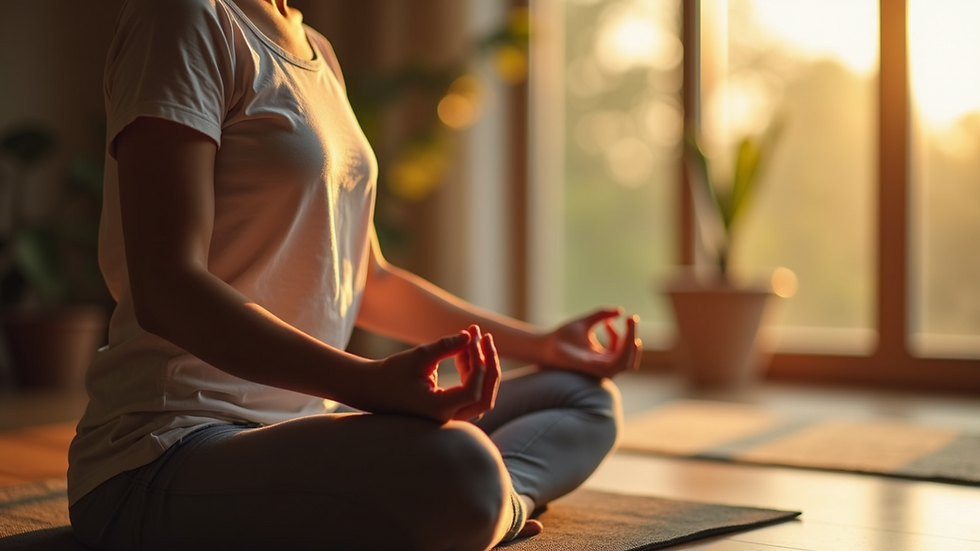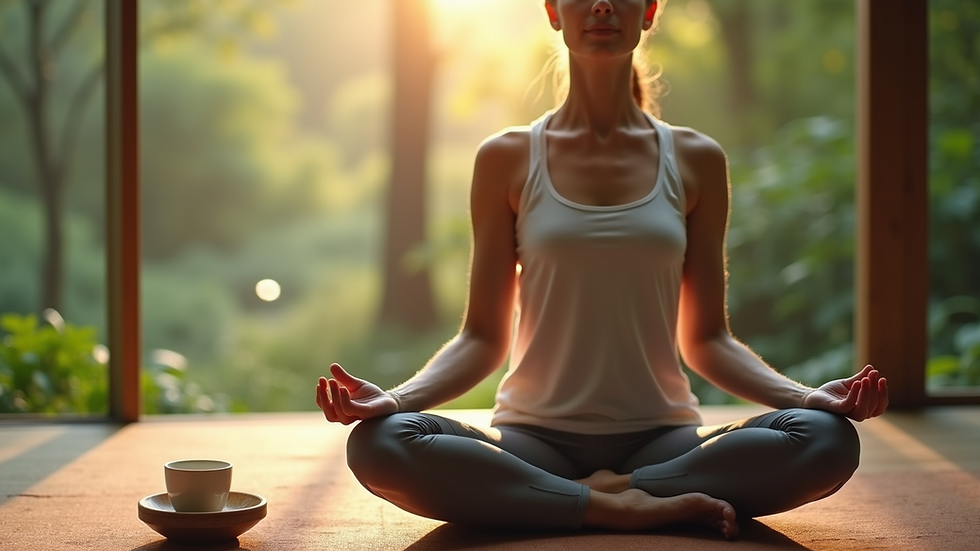Simple Techniques to Manage Anxiety at Home
- Sydnie Kelman
- Sep 8
- 5 min read
Anxiety can feel overwhelming, especially when it creeps into our daily lives. Many people experience anxiety at some point, whether it’s due to work stress, personal issues, or global events. The good news is that there are simple techniques you can use at home to help manage anxiety. This post will explore practical strategies that can make a difference in your daily life.
Anxiety often manifests in physical symptoms, such as a racing heart, sweating, or difficulty concentrating. Recognizing these signs is the first step toward managing them. By implementing some easy techniques, you can create a calming environment and develop habits that promote relaxation.
Create a Calming Space
One of the first steps in managing anxiety at home is to create a calming space. This area should be free from distractions and clutter. Here are some tips to help you set up your space:
Choose a Quiet Location: Find a spot in your home where you can be alone and undisturbed. This could be a corner of your bedroom, a cozy chair in the living room, or even a spot in your garden.
Add Comforting Elements: Incorporate items that make you feel relaxed. This could include soft pillows, a warm blanket, or your favorite books.
Use Soothing Colors: Paint the walls in soft, calming colors like light blue or green. These colors can help create a peaceful atmosphere.
Incorporate Nature: Adding plants can improve air quality and create a sense of tranquility. Consider low-maintenance plants like succulents or peace lilies.
Creating a calming space can help you feel more grounded and less anxious.
Practice Deep Breathing
Deep breathing is a simple yet effective technique to manage anxiety. It helps calm your mind and body. Here’s how to practice deep breathing:
Find a Comfortable Position: Sit or lie down in your calming space.
Close Your Eyes: This can help you focus on your breath.
Inhale Slowly: Breathe in deeply through your nose for a count of four. Feel your abdomen expand.
Hold Your Breath: Hold your breath for a count of four.
Exhale Slowly: Breathe out through your mouth for a count of four. Imagine releasing your tension with each exhale.
Repeat: Continue this cycle for several minutes.
Deep breathing can help reduce feelings of anxiety and promote relaxation.
Establish a Routine
Having a daily routine can provide structure and predictability, which can be comforting during anxious times. Here are some tips for establishing a routine:
Set Regular Wake-Up and Sleep Times: Try to go to bed and wake up at the same time each day. This helps regulate your body’s internal clock.
Plan Your Day: Create a simple schedule that includes time for work, relaxation, and self-care.
Include Breaks: Make sure to schedule short breaks throughout your day. Use this time to stretch, take a walk, or practice deep breathing.
Limit Screen Time: Set boundaries for how much time you spend on screens, especially before bed. This can help improve your sleep quality.
A consistent routine can help you feel more in control and less anxious.
Engage in Physical Activity
Physical activity is a powerful tool for managing anxiety. Exercise releases endorphins, which can improve your mood. Here are some ways to incorporate physical activity into your day:
Go for a Walk: A simple walk around your neighborhood can clear your mind and reduce anxiety.
Try Yoga: Yoga combines physical movement with mindfulness. There are many online classes available for all skill levels.
Dance: Put on your favorite music and dance around your living room. It’s a fun way to get moving and lift your spirits.
Gardening: If you have a garden, spending time tending to plants can be therapeutic.
Find an activity you enjoy and make it a regular part of your routine.
Practice Mindfulness
Mindfulness is the practice of being present in the moment. It can help reduce anxiety by shifting your focus away from worries about the past or future. Here are some ways to practice mindfulness at home:
Meditation: Set aside a few minutes each day to meditate. Focus on your breath or use a guided meditation app.
Mindful Eating: Pay attention to the taste, texture, and smell of your food. Eating slowly can enhance your experience and help you feel more grounded.
Gratitude Journaling: Write down three things you are grateful for each day. This practice can shift your focus from anxiety to positivity.
Engage Your Senses: Take a moment to notice what you see, hear, smell, and feel around you. This can help anchor you in the present.
Mindfulness can be a powerful tool for managing anxiety and improving your overall well-being.
Limit Caffeine and Sugar
Caffeine and sugar can increase feelings of anxiety for some people. Here are some tips for managing your intake:
Choose Herbal Teas: Instead of coffee or caffeinated drinks, opt for herbal teas like chamomile or peppermint. These can be soothing and help reduce anxiety.
Read Labels: Be mindful of hidden sugars in processed foods. Opt for whole foods whenever possible.
Stay Hydrated: Drink plenty of water throughout the day. Dehydration can contribute to feelings of anxiety.
By being mindful of what you consume, you can help manage your anxiety levels.
Connect with Others
Social connections are important for mental health. Even when you are at home, there are ways to connect with others:
Video Calls: Schedule regular video calls with friends or family. Seeing a familiar face can boost your mood.
Join Online Groups: Look for online communities that share your interests. This can help you feel connected and supported.
Reach Out: Don’t hesitate to reach out to someone if you are feeling anxious. Talking about your feelings can be incredibly helpful.
Building and maintaining connections can provide support and reduce feelings of isolation.
Limit News Consumption
In today’s world, it’s easy to become overwhelmed by news and social media. Here are some tips to manage your news consumption:
Set Time Limits: Decide how much time you will spend on news each day. Stick to this limit to avoid feeling overwhelmed.
Choose Reliable Sources: Follow trustworthy news outlets and avoid sensationalist media.
Take Breaks: If you find yourself feeling anxious after consuming news, take a break. Focus on activities that bring you joy instead.
Managing your news consumption can help reduce anxiety and improve your mental well-being.
Seek Professional Help
If anxiety becomes overwhelming, it may be time to seek professional help. Here are some options to consider:
Therapy: A therapist can provide support and teach you coping strategies. Look for a therapist who specializes in anxiety.
Support Groups: Joining a support group can help you connect with others who understand what you are going through.
Medication: In some cases, medication may be necessary. Consult with a healthcare professional to discuss your options.
Seeking help is a sign of strength, and it can lead to significant improvements in your mental health.
Embrace Self-Compassion
Finally, it is important to practice self-compassion. Be kind to yourself as you navigate anxiety. Here are some ways to embrace self-compassion:
Acknowledge Your Feelings: It’s okay to feel anxious. Recognize your feelings without judgment.
Practice Positive Self-Talk: Replace negative thoughts with positive affirmations. Remind yourself that you are doing your best.
Take Time for Yourself: Make self-care a priority. Engage in activities that bring you joy and relaxation.
Self-compassion can help you build resilience and cope with anxiety more effectively.
Finding Your Path to Calm
Managing anxiety at home is a journey, not a destination. By implementing these simple techniques, you can create a more peaceful environment and develop habits that promote relaxation. Remember, it is okay to seek help when needed. You are not alone in this journey.
As you explore these techniques, be patient with yourself. It may take time to find what works best for you. Celebrate your progress, no matter how small. With practice and persistence, you can find your path to calm and enjoy a more peaceful life at home.

%20copy%203.png)


Comments